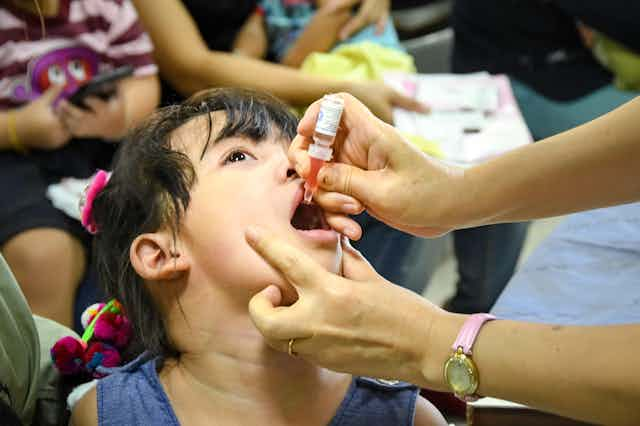Recent reports of poliovirus detected in samples from a sewage treatment works in London have rightly generated significant concern among public health agencies and medical staff. The poliovirus detected is what is called vaccine-derived poliovirus – this is not “wild poliovirus”.
There are currently two poliovirus vaccines: the oral poliovirus vaccine (OPV) and the inactivated poliovirus vaccine (IPV). Vaccine-derived poliovirus is linked to the use of the OPV as this vaccine uses weakened poliovirus to produce an immune response.
The weakened poliovirus can still infect people and be shed by the vaccinated person. This can result in the weakened virus spreading from person to person. And in rare cases, this weakened poliovirus can change to a more dangerous strain of the virus that can cause disease.
In areas with high levels of vaccination, the community is protected and the spread of the more dangerous virus is stopped. But in areas with lower vaccination rates, unvaccinated people may be exposed to poliovirus that has originated as a weakened vaccine strain but is now a more dangerous version. This virus is referred to as a vaccine-derived poliovirus.
As the global vaccine initiatives have resulted in the near eradication of poliovirus, the number of cases of vaccine-derived poliovirus has overtaken the number of infections with wildtype poliovirus. In 2021, there were 697 new cases of vaccine derive poliovirus compared with just six cases of wildtype poliovirus, globally.

Vaccination with IPV does not immunise people with an infectious virus. Instead, it uses poliovirus that has been chemically inactivated. This means the virus is unable to infect people, removing the risk of vaccine-derived poliovirus. This vaccine is considered very safe. For this reason, many countries have moved away from using OPV and adopted IPV.
The UK switched from using OPV to IPV in 2004. However, OPV remains an incredibly effective vaccine that has been instrumental in bringing about the near eradication of poliovirus and remains widely used throughout the world.
While there is no risk of vaccine-derived poliovirus infection when using the IPV, the making of IPV does lead to a potential biohazard risk. To make IPV, large volumes of infectious poliovirus must be produced and then inactivated. This large-scale production of poliovirus has inherent risks and any breach of biocontainment in a population with low vaccine coverage can have serious consequences as poliovirus could be reintroduced.
Safer vaccine made from yeast
Vaccination strategies with either OPV or IPV, therefore, involve a certain level of risk. In either case, the risk is astonishingly low. However, for some time scientists have been seeking to develop new and safer methods for poliovirus vaccination. One potential candidate for a new poliovirus vaccine is the use of virus-like particles (VLPs).
VLPs are assembled from the proteins that make up the outer shell of the virus, called a capsid. This allows the immune system to react to this empty shell and triggers a protective immune memory response, so the next time the immune system is exposed to a viral capsid (such as in the case of a viral infection), it can generate an effective response that rapidly controls and eliminates the virus.
Because VLPs contain no genetic material from the virus, they are safe to manufacture and use without the risk of spreading the actual disease. This method has already been used very effectively to produce the human papillomavirus vaccine.
A further advantage of using VLP vaccines for a disease such as poliovirus is the potential to produce VLPs in production systems such as yeast. At the University of Leeds, we have shown that yeast can be made to produce poliovirus VLPs and then grown in large quantities.
The production system for these VLPs uses a similar infrastructure to other yeast-based manufacturing, such as the brewing of beer. This means that large quantities of VLPs can be produced quickly and safely in a very cost-effective way.

